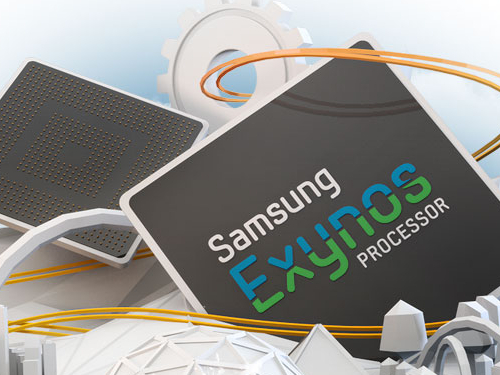''Evolved'' Exynos 5 Octa Still Has Two Core Sets
Samsung has replaced the GPU cores and cranked up the clock speed of the CPU cores just a notch.
On Monday during SIGGRAPH 2013, Samsung revealed its "evolved" Exynos 5 Octa SoC after tossing out teases on Twitter over the last several weeks. Called the Exynos 5420, the updated chip still separates its eight cores into two sets thanks to the big.LITTLE setup, so it will still only utilize four at a time. What Samsung has done is ripped out the three PowerVR SGX544MP3 GPU cores (which clocked at 533 MHz) and threw in six ARM Mali-T628 GPU cores.
Samsung indicated that it has also cranked up the clock speeds of the chip's CPU cores, pushing the four Cortex-A15 cores from 1.6 GHz to 1.8 GHz and the four Cortex-A7 cores from 1.2 GHz to 1.3 GHz. Samsung said this presents a 20 percent improvement in processing capability over the former Exynos 5 Octa chip, the Exynos 5410, by optimizing the power saving design.
"The multiple image compression (MIC) IP block inside this System-on-Chip successfully lowers the total system power when bringing pictures or multimedia from memory to display panel," the company said. "This feature results in maximizing the usage hours of mobile devices with a high-resolution display such as WQXGA (250 x1600), in particular when browsing the web or doing multimedia application requiring the frequent screen refresh."
The new chip also has a memory bandwidth of 14.9 GB/s paired with a dual-channel LPDDR3 at 933 MHz, enabling fast data processing and support for a full HD Wi-Fi display. It also contains a variety of full HD 60 frames per second video hardware codec engines for 1080p video recording and playback. The chip is even capable of performing General-Purpose computing on Graphics Processing Units (GPGPU), and supports OpenGL ES 3.0 and Full Profile Open CL 1.1.
"ARM welcomes the latest addition to the successful Exynos Octa 5 series, which uses ARM’s Mali GPU solution to dramatically improve graphics performance," said Pete Hutton, executive vice president & general manager, Media Processing Division, ARM. "ARM big.LITTLE and ARM Artisan Physical IP technologies continue to be at the heart of the Octa series and now complement the new functionality brought by ARM GPU Compute. This combination enables unprecedented capabilities in areas such as facial detection and gesture control, and brings desktop-quality editing of images and video to mobile devices."
The new family of Exynos 5 Octa is currently sampling to customers and is scheduled for mass-production in August.
Get Tom's Hardware's best news and in-depth reviews, straight to your inbox.

Kevin Parrish has over a decade of experience as a writer, editor, and product tester. His work focused on computer hardware, networking equipment, smartphones, tablets, gaming consoles, and other internet-connected devices. His work has appeared in Tom's Hardware, Tom's Guide, Maximum PC, Digital Trends, Android Authority, How-To Geek, Lifewire, and others.
-
I think a 6 core design would have been better. 2 cores is all that is needed to run the OS well so it should have 2 power saving cores and 4 performance cores. This would save more energyReply
-
eastyy still puzzled why a intelligent quad core would be any different if the quad core turned of cores and reduced clock speed when neededReply -
eastyy still puzzled why a intelligent quad core would be any different if the quad core turned of cores and reduced clock speed when neededReply -
SlitWeaver Could you imagine actually trying to use a screen with a resolution of 250 x 1600? Great for reading...maybe? lol TH, you should fix that ;)Reply -
darkchazz Thanks to Samsung's closed sources, their exynos devices will never get stable cyanogenmod/AOKP roms. This one won't be any different.Reply
Just take a look at the SGS4 xda page. The amount of development happening with the exynos octa (i9500) variant is pathetic compared to the snapdragon (i9505 LTE) variant. -
halcyon Did any US-bound phones get the 5410? It would be a neat conversation piece to see the 5420 in the Note 3.Reply -
silverblue "What Samsung has done is ripped out the three PowerVR SGX544MP3 GPU cores (which clocked at 533 MHz) and threw in six ARM Mali-T628 GPU cores."Reply
Sorry, I'd have put "thrown" (i.e. they have thrown as opposed to they have threw). -
renz496 i'm don't follow much about SoC stuff but why need up to four cores for the 'slow' cores? the slow cores supposed to handle low cpu intensive work so does it really need that many cores (in this case 4) to handle all the light task?Reply
